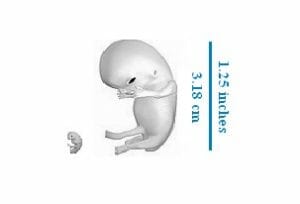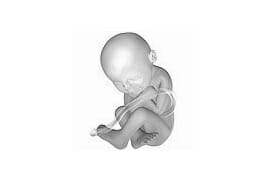Fetus Definition
Fetal development occurs between the embryonic stage of development and birth in humans. This stage begins after 11 weeks of gestation, when the embryo begins to exhibit human characteristics, and lasts until birth. Typically, all the major organs and tissues can be observed; however, they are not yet fully developed or appropriately situated within the body.
Fetus Stages
Throughout the process of fetal development, the growing fetus goes through three distinct stages, each characterized by specific events.
2 ¼ to 4 months
As the embryo enters the fetal stage of development, the placenta becomes functional. The fetus typically measures 30 mm from the crown to the rump and weighs approximately 8 g (shown below). By the end of this stage, the fetus is approximately 15 cm. During this time, several organs can be observed, including the hands, feet, heart, and brain. The pancreas and liver begin to secrete fluids. In addition, the genitals begin form and the head is prominent, comprising almost half of the fetal body. The fetus also exhibits unregulated movements required for the lung, muscle, and neurological development that is occurring.
4 ¼ to 6 ¼ months
During this period of fetal development, the mother begins to feel the movements of the growing fetus, which grows from approximately 15 cm to 38 cm and weighs about 500 g by the end of this stage (shown below). During this stage, the eyebrows and eyelashes form, muscle development increases and the fetus becomes more active, the lung continues to develop with the formation of the alveoli. In addition, the nervous system rapidly develops, exhibited by the development of the inner ear, control over the opening and closing of the eyelids, as well as other bodily processes. The genitals are fully formed and the sex can be reliably discerned.
6 ½ to 9 ½ months
At this stage, the fetus begins to gain weight as the body fat increases. The lungs continue to mature and become capable of gas exchange. In addition, hair begins to thicken on the head and breast buds appear. The fetus is considered to be full-term at approximately 38 weeks (between 36 and 40 weeks) of pregnancy (shown below). While fetuses born prior to 36 weeks can survive outside the uterus, medical intervention is required to promote survival, particularly due to the underdevelopment of the lungs in premature infants.
Quiz
1. Which of the following statements is TRUE:
A. The lungs are one of the first organs to fully mature in a developing fetus.
B. The heart is one of the first organs to form in the developing fetus.
C. The sex of the fetus can be observed as early as 13 weeks.
D. A fetus born at 37 weeks has a low probability of survival.
2. The fetus becomes increasingly active due to:
A. Increased neurological development
B. Increased muscle development
C. Increased bone and limb development
D. All of the above
References
- Del Valle et al. (2017). A genomic atlas of human adrenal and gonad development. Wellcome Open Res.2:25.
- Gilbert SF. (2000). Developmental Biology. 6th edition. Sinauer Associates; Sunderland (MA).
- Meyeer G, Schaaps, JP, Moreau L, and Goffinet AM. (2000). Embryonic and Early Fetal Development of the Human Neocortex. Journal of Neuroscience. 20 (5): 1858-1868.
- Sandikcioglu M, Mølsted K, and Kjaer I. (1994). The prenatal development of the human nasal and vomeral bones. Journal of Craniofacial Genetics and Developmental Biology. 14(2):124-134.



